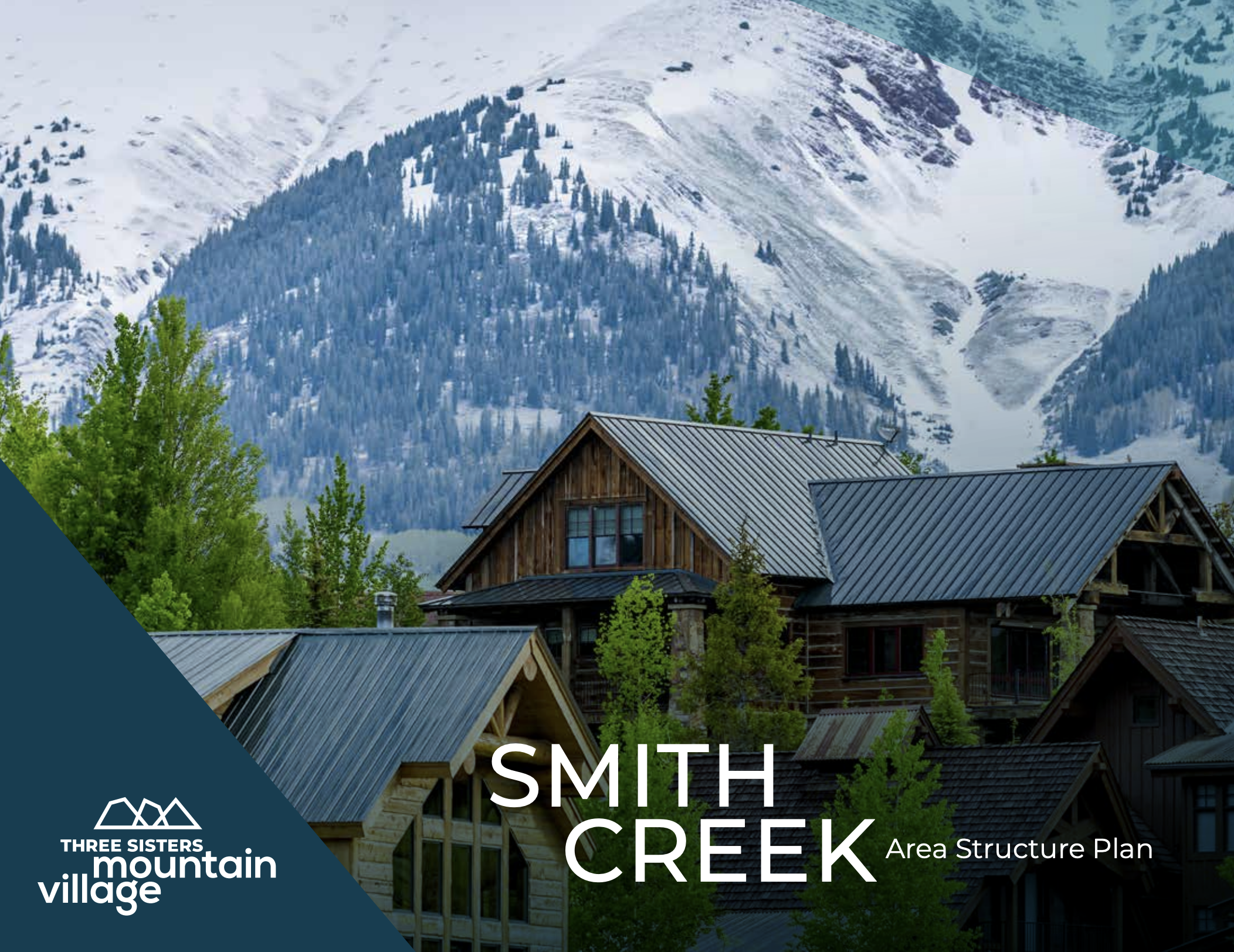Making decisions today for a shared future in Three Sisters.
Everyone wants a piece of Canmore, and rightly so; it's a pretty great place to be.
Decisions made regarding the Three Sisters property, a landscape that constitutes 80 per cent of the remaining developable land in Canmore, Alberta, have a significant impact on the town’s social and economic future and directly affect the health of our local and regional wildlife populations.
What is at stake?
If approved, these two developments would roughly double the size of Canmore, with estimated accommodation for approximately 14,500 residents
Three Sisters Mountain Village (TSMV) is seeking to develop the Three Sisters property from the unfinished Three Sisters Golf Course east to Dead Man's Flats. As of 2021 there are two projects proposed for this land, Three Sisters Village Centre (formerly Resort Centre) and Smith Creek.
If approved, these two developments would roughly double the size of Canmore, with estimated accommodation for approximately 14,500 additional residents according to TSMV’s FAQ page: 10,000 projected at Three Sisters Village and 4,500 projected at Smith Creek. These numbers are greater by about 25% than what was proposed and rejected by Town Council in 2017.
Two similar proposals were submitted by TSMV in 2016 and both were rejected:
The proposed development at Three Sisters Village (then known as Resort Centre) was turned down by Canmore town council in 2017.
In 2018, Alberta Environment and Parks rejected Three Sisters’ proposed wildlife corridor alignment, one that would allow development to begin at Smith Creek, stating the width of the corridor at the eastern end of Smith Creek was "not satisfactory.” In a move that blindsided the community and the Town, this same alignment was approved under the new government in 2020.
Canmore’s economy, liveability, greenhouse gas emissions, wildlife and way of life will be affected by this development. Public hearings and other events and platforms will be held with the goal of seeking public feedback and guiding the approval, amendment or rejection of these proposals again in 2021.
LOOKING FOR MORE BACKGROUND? HEad to the Town of Canmore’s TSMV page or CLICK BELOW TO READ OUR EXTENSIVE OVERVIEW OF THE LAST PROPOSAL THAT WAS STRUCK DOWN BY TOWN COUNCIL IN 2018.
Speaking up for what makes Canmore special
Since 1992 the community has raised specific concerns about these proposals. These Include:
Economic liabilities relating to engineering failures caused by building on heavily undermined land
Threats to citizen and wildlife safety posed by the requirement for a fence to surround the developments
Risks posed by increasing development in a valley already known to be an extreme wildfire risk zone
High risk to the functionality of a continentally-significant wildlife corridor
Economic and jurisdictional uncertainties of managing inevitable wildlife corridor fence repairs, fence breaches and wildlife interactions
Social, economic and environmental effects of doubling the town’s population including strain on the fire department, solid waste services and more
Climate concerns associated with sprawl and development, in light of Canmore’s recent declaration of climate emergency
Lack of consultation with local Indigenous communities
The attempt to force significant changes to the town’s Municipal Development Plan that favour development and threaten wildlife.
Scope of residential growth projected at TSMV
This graph shows the scope of combined residential units in TSMV proposals compared to existing residential units in neighbouring towns. Compiled and submitted by Jacob Herrero. Source: Stats Canada (2016) and three TSMV ASPs.
The design of development on these lands should be guided by robust scientific understanding of ecological integrity and wildlife movement, a risk-averse approach (the precautionary principle) to building on undermined lands, and a 200-year view towards sustainability and resilience. If it is, Canmore’s “small town feel,” community values, and quality of life, as well as the valley’s ecosystems and wildlife, will have a good chance of thriving long into the future.
Now it is a question of what we are willing to risk for the sake of a couple more decades worth of development.
It’s complicated.
A historical summary and overview:
Since 1992, a parade of different ownership groups and developers have had various plans for these lands. Economic booms and busts have dictated many of the decisions. Throughout it all, the community has been consistent in their desire to be involved. Many have been a voice for wildlife.
Want a full history of these lands dating back to 1992?
An overview of the 2020/21 proposals
The community has been consistent in their desire to be involved.
The plans below passed first reading by Town Council on February 9, 2021. A public hearing that lasted a record six days took place between March 9th and 16th, 2021.
Among other things, the original approvals granted by the NRCB back in 1992 for a future resort on these lands imagined a maximum (not a guarantee) of 2,425 hotel rooms and 6,085 housing units on lands impacted by the decision. These current TSMV proposals request that the town grant them the ability to build over and above these limits. The 1992 decision also stated that “low and modest cost housing would make up over 60 per cent of all proposed residential units” which is not reflected in these proposals.
Both proposals are in conflict with the Town’s Municipal Development Plan and would require significant changes to the MDP, including expanding Canmore’s growth boundary in order to be accommodated. The Village Centre plan would require rezoning a large existing private recreation zone (the golf course that has never been completed) to a new zoning for commercial/residential, and Smith Creek would require rezoning 80 acres of wildlands conservation for commercial/residential and expanding the town’s growth boundary. Read more here about how ASPs and MDPs relate to each other.
A wildlife fence surrounding the developments has been calculated by TSMV’s environmental consultants (Golder) to be a requirement in order for the wildlife corridor to be considered functional alongside the proposed developments. There is no directly comparable application of such a fence being used successfully to separate an urban development from a wildlife corridor such as the one at Three Sisters. MSES, the third-party reviewer hired to analyze Golder’s environmental impact statement, wrote in their report that they “do not share [Golder’s] confidence that all the mitigations will be effective” and Y2Y’s Hilary Young describes the use of fences in this case as essentially a “risky, unproven, high-stakes experiment.”
Combined, the projects are expected to provide up to 2,300 temporary construction jobs.
The unfinished golf course lands, which are currently considered a necessary wildlife “buffer zone” that effectively widens the official wildlife corridor, are now being proposed by TSMV to be built out with a high density commercial and residential mix at Village Centre. The corridor has a significantly narrow pinch point in its design at this location. This is why the decision to ensure these lands remain zoned as a golf course and effective wildlife buffer zone was part of an agreement within their 2004 Area Structure Plan that has allowed TSMV to develop most of what they have built to date. See below for the scope of what is being proposed on this site, including 5000 hotel rooms, residences for 10,000 people and 199,000 square feet of commercial space.
The other primary reason for zoning the Village Centre lands as a golf course is because they are heavily undermined by 100 years of coal mining in the area. They were not considered suitable for development other than as a golf course in 2004 but with new mitigation techniques, TSMV proposes it is now safe.
Smith Creek
Smith Creek in green. Map at TSMV.ca
UPDATE: The Smith Creek project was defeated at second reading on April 27, 2021. It will not move forward as a development in its current form.
Located east of Stewart Creek Golf Course at Three Sisters Mountain Village, and ending at Thunderstone Quarry at Dead Man’s Flats, Smith Creek is a development that was proposed near Wind Valley pass, a key connection for wildlife moving east-west in and out of the protected areas in Kananaskis Country.
The Smith Creek ASP proposed:
An expansion of the Town’s Urban Growth Boundary through an amendment to the Municipal Development Plan (MDP)
Rezoning 80 acres of “Conservation of Wildlands” zoning for development.
4,500 new permanent residents
1,700 new homes, 70 per cent single detached, semi-detached or townhomes
74,000 square feet of business and light industrial space
125,000 square feet of retail and commercial space
Three Sisters Village Centre
Village Centre in blue. Map at TSMV.ca
UPDATE: The Village Centre proposal has been given third reading by town council as of April 27, 2021. Proposed amendments to the plan can be found here.
Formerly called Resort Centre, Three Sisters Village Centre is proposed for land west of Stewart Creek Golf Course on another (unfinished) golf course near Three Sisters Creek.
Historically, these lands saw heavy coal development from 1889 to 1979 so undermining is an issue. The area will require mine shaft mitigation to make it safe to build residential, commercial and recreational developments on.
The Three Sisters Village Centre ASP proposes:
Rezoning a golf course sized piece of land from private recreation to commercial/residential zoning. This would require significant amendments to the town’s existing Municipal Development Plan.
10,000 new permanent (full and part-time) residents
5,000 hotel rooms for short-term visitors
220,000 square feet of office and industrial manufacturing space
188,000 square feet of indoor recreation and entertainment space
380,000 square feet for retail, dining and spa services
240 beds for staff accommodation/employee housing
This ASP proposes 10 per cent of multi-residential units will be considered “vital homes” by the Canmore Community Housing program (formerly called Perpetually Affordable Housing) in addition to an estimated 330 to 880 purpose-built rental units and secondary suites.
“Broadsided” by an announcement
In late February 2020, Alberta Environment and Parks shocked the community with a surprise approval of the Smith Creek corridor for Three Sisters Mountain Village.
Blackwood’s presentation starts at 5m 32s in the video.
Residents and town council were caught off guard by this news. Hundreds of concerned community members showed up in-person at the March 3, 2020 town council meeting to try and gain a better understanding of the unexpected announcement and decision. Rick Blackwood, then assistant deputy minister of Environment and Parks, presented this decision to Town Council.
Staff at the environmental non-profit Yellowstone to Yukon Conservation Initiative (Y2Y) said they and others in the community felt “broadsided” and that the decision was “made completely behind closed doors.” They requested Alberta Environment and Parks share the scientific data behind the proposal documents and make them fully available for public review and consultation. (Something that did happen, eventually.)
This announcement followed Alberta Environment and Parks’ 2018 rejection of a similar proposal which stated the width of the corridor at the eastern end of Smith Creek was "not satisfactory” for sustained wildlife movement.


















